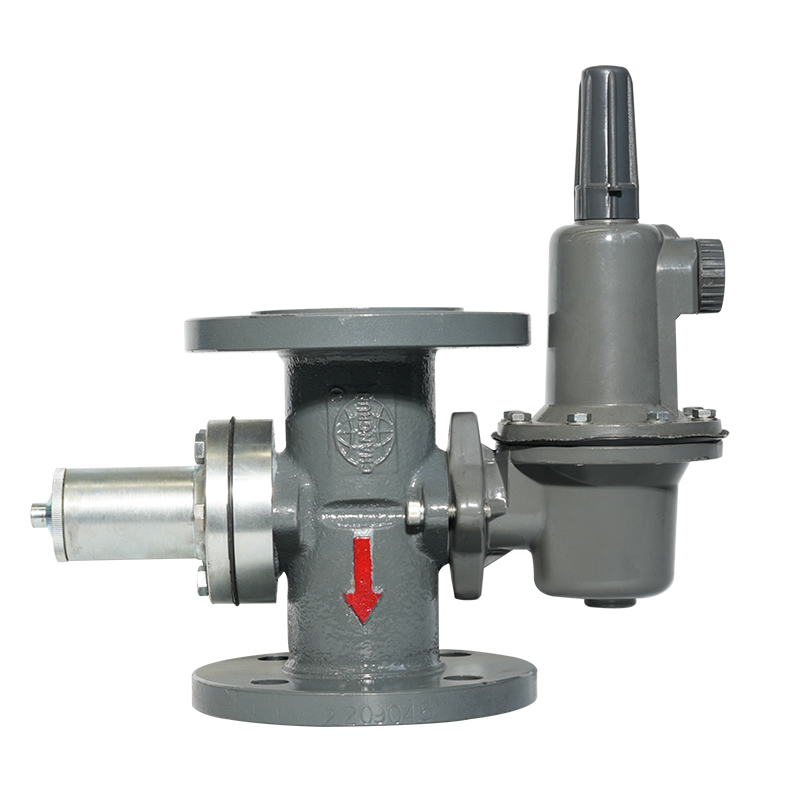Pipeline gas pressure reducing valve, regulator
The gas pressure regulator is a key device to maintain the stability of the downstream pressure of the gas pipeline. It automatically changes the gas ...
See DetailsGas pressure regulators serve as critical control components within gas delivery systems, operating on the fundamental principle of force balance and automatic media characteristic adjustment to maintain consistent outlet pressure. When inlet pressure or flow rate experiences fluctuations, the integrated diaphragm assembly detects these pressure variations and actuates the valve plug through linkage mechanisms, thereby modifying the flow area to achieve precise pressure regulation. Modern regulators typically employ either direct-acting or pilot-operated designs, incorporating essential safety features such as over-pressure shutoff devices and safety relief valves. Manufactured predominantly from cast steel or stainless steel materials with precision-machined internal components ensuring optimal sealing performance, these regulators feature spring adjustment mechanisms that allow operators to accurately set output pressures within specified ranges. These structural characteristics enable pressure regulators to maintain stable outlet pressure under various operating conditions, ensuring the safe operation of downstream equipment.
Selecting appropriate gas pressure regulators requires comprehensive consideration of multiple engineering parameters. Primary considerations include determining maximum and minimum inlet pressure ranges, required outlet pressure accuracy, and maximum flow capacity requirements. CV value calculations must account for gas density, temperature, and viscosity characteristics while maintaining adequate capacity margins to accommodate load fluctuations. For high differential pressure applications, thorough evaluation of noise levels and cavitation risks is essential, potentially necessitating multi-stage pressure reduction solutions. Explosive environments demand products with appropriate explosion-proof certifications, while material selection must consider potentially corrosive components such as hydrogen sulfide or moisture present in the gas stream. Installation methods, connection sizes, and directional requirements also constitute critical factors in the selection process, collectively determining the regulator's performance and reliability in practical applications.
The installation quality of high-pressure gas regulators directly impacts system safety and regulation accuracy. Installation locations should be selected in well-ventilated areas with adequate maintenance access, avoiding proximity to heat sources and vibrating equipment. Pipeline configuration must ensure sufficient straight pipe lengths upstream to stabilize flow fields, while downstream piping should meet safety venting requirements. Pre-commissioning procedures require thorough pipeline purging to eliminate contaminants, followed by gradual pressure increase to verify sealing integrity. During commissioning activities, calibrated pressure gauges must monitor inlet pressure variations while carefully adjusting spring tension until achieving set outlet pressure. Following basic adjustments, dynamic testing should simulate sudden flow changes to validate regulation response speed and stability, ensuring maintained output pressure consistency across all operational scenarios.
Typical gas regulator failures include pressure fluctuations, leakage issues, and response delays. Pressure oscillations often result from diaphragm aging, spring fatigue, or valve seat wear; leakage problems typically stem from sealing surface damage or contaminant obstruction; slow response times may originate from transmission mechanism corrosion or pilot tube blockage. Establishing preventive maintenance programs involves regular inspection of diaphragm elasticity, spring characteristic measurements, filter cleaning, and safety device calibration. For critical applications, parallel standby pipelines are recommended to enable online maintenance without system interruption. Maintenance records should meticulously document parameter trends from each inspection, providing valuable data support for predictive maintenance strategies. Operator training remains equally important, ensuring personnel can identify abnormal conditions and implement appropriate response measures promptly.
Gas pressure regulators must undergo rigorous safety performance testing before being deployed in practical applications. Type testing encompasses shell strength verification, sealing performance evaluation, regulation accuracy assessment, endurance testing, and emergency shutoff function validation. Routine factory inspections require individual leakage testing and set pressure calibration for each unit, with critical projects necessitating third-party certification reports. Internationally recognized certification standards include the ISO 23551 series, EN 334 specifications, and ASME B16.33 regulations. These standards provide detailed requirements for material selection, structural design, testing methodologies, and marking specifications. Manufacturers must establish comprehensive quality management systems ensuring compliance with relevant regulatory requirements throughout all stages from raw material procurement to finished product delivery, thereby providing users with safe and reliable product assurance.
Contemporary gas pressure regulator designs incorporate advanced materials and technological innovations to enhance performance and reliability. Specialized elastomers and composite materials are being developed for diaphragm applications, offering improved resistance to gas composition variations and temperature extremes. Surface treatment technologies including special coatings and hardening processes significantly extend the service life of critical components such as valve seats and moving parts. Smart regulator designs now integrate pressure sensors, temperature compensation elements, and digital communication capabilities enabling real-time performance monitoring and remote adjustment functionality. These technological advancements facilitate predictive maintenance scheduling, optimize energy consumption, and provide valuable operational data for system efficiency improvements. The integration of these innovations represents the ongoing evolution of gas pressure regulation technology toward greater intelligence, reliability, and operational efficiency.

Contact Us